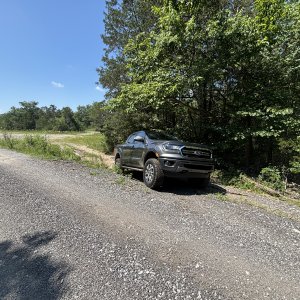Thanks for the help guys!
@Pete, I changed out the fuel filter not too long ago, it was actually last spring. It was a Wix filter, so I am assuming its still fine. I suppose I shall change that anyway.
I found this article on ALLDATA and wanted to help out some other members pertaining to this issue.
LIGHT TRUCK:
1990 BRONCO II
1990-99 RANGER
1991-99 EXPLORER
1994-96 BRONCO
ISSUE
This TSB article is a diagnostic procedure to address vehicles that exhibit lean driveability symptoms and may or may not have any Diagnostic Trouble Codes (DTCs) stored in memory.
MASS AIR FLOW (MAF) DISCUSSION
MAF sensors can get contaminated from a variety of sources: dirt, oil, silicon, spider webs, potting compound from the sensor itself, etc. When a MAF sensor gets contaminated, it skews the transfer function such that the sensor over-estimates air flow at idle (causes the fuel system to go rich) and under-estimates air flow at high air flows (causes fuel system to go lean). This means Long Term Fuel Trims will learn lean (negative) corrections at idle and learn rich (positive) corrections at higher air flows.
If vehicle is driven at Wide Open Throttle (WOT) or high loads, the fuel system normally goes open loop rich to provide maximum power. If the MAF sensor is contaminated, the fuel system will actually be lean because of under-estimated air flow. During open loop fuel operation, the vehicle applies Long Term Fuel Trim corrections that have been learned during closed loop operation. These corrections are often lean corrections learned at lower air flows. This combination of under-estimated air flow and lean fuel trim corrections can result in spark knock/detonation and lack of power concerns at WOT and high loads.
One of the indicators for diagnosing this condition is barometric pressure. Barometric pressure (BARO) is inferred by the Powertrain Control Module (PCM) software at part throttle and WOT (there is no actual BARO sensor on MAF-equipped vehicles, except for the 3.8L Supercharged engine). At high air flows, a contaminated MAF sensor will under-estimate air flow coming into the engine, hence the PCM infers that the vehicle is operating at a higher altitude. The BARO reading is stored in Keep Alive Memory (KAM) after it is updated. Other indicators are Long Term Fuel Trim and MAF voltage at idle.
Symptoms
^ Lack of Power
^ Spark Knock/Detonation
^ Buck/Jerk
^ Hesitation/Surge on Acceleration
^ Malfunction Indicator Lamp (MIL) Illuminated -
DTCs
P0171, P0172, P0174, P0175 may be stored in memory
OBDII DTCs
^ P0171, P0174 (Fuel system lean, Bank 1 or 2)
^ P0172, P0175, (Fuel system rich, Bank 1 or 2)
^ P1130, P1131, P1132, (HO2S11 lack of switching, Bank 1)
^ P1150, P1151, P1152, (HO2S21 lack of switching, Bank 2)
OBDI DTCs
^ 181, 189 (Fuel system lean, Bank 1 or 2)
^ 179, 188 (Fuel system rich, Bank 1 or 2)
^ 171, 172, 173 (HO2S11 lack of switching, Bank 1)
^ 175, 176, 177 (HO2S21 lack of switching, Bank 2)
^ 184, 185 (MAF higher/lower than expected)
^ 186, 187 (Injector pulse width higher/lower than expected)
1. Look at the BARO PID. Refer to the Barometric Pressure Reference Chart in this article. At sea level, BARO should read about 159 Hz (29.91 in. Hg). As a reference, Denver, Colorado at 1524 meters (5000 ft.) altitude should be about 144 Hz (24.88 in.Hg). Normal learned BARO variability is up to +/- 6 Hz (+/- 2 in. Hg.). If BARO indicates a higher altitude than you are not at (7 or more Hz lower than expected), you may have MAF contamination. If available, Service Bay Diagnostic System (SBDS) has a Manifold Absolute Pressure (MAP) sensor that can be used as a barometric pressure reference. Use "MAP/BARO" test under "Powertrain," "Testers and Meters." Ignore the hookup screen. Connect GP2 to the reference MAP on the following screen.
2. On a fully warmed up engine, look at Long Term Fuel Trim at idle, in Neutral, A/C off, (LONGFT1 and/or LONGFT2 PIDs). If it is more negative than -12%, the fuel system has learned lean corrections which may be due to the MAF sensor over-estimating air flow at idle. Note that both Banks 1 and 2 will exhibit negative corrections for 2-bank system. If only one bank of a 2-bank system has negative corrections, the MAF sensor is probably not contaminated.
3. On a fully warmed up engine, look at MAF voltage at idle, in Neutral, A/C off (MAF V PID). If it's 30% greater than the nominal MAF V voltage listed in the Powertrain Control/Emissions Diagnosis (PC/ED) Diagnostic Value Reference Charts for your vehicle, or greater than 1.1 volts as a rough guide, the MAF sensor is over-estimating air flow at idle.
4. If at least two of the previous three steps are true, proceed to disconnect the MAF sensor connector. This puts the vehicle into Failure Mode and Effects Management (FMEM). In FMEM mode, air flow is inferred by using rpm and throttle position instead of reading the MAF sensor. (In addition, the BARO value is reset to a base/unlearned value.) If the lean driveability symptoms go away, the MAF sensor is probably contaminated and should be replaced. If the lean driveability symptoms do not go away, go to the PC/ED Service Manual for the appropriate diagnostics.
After replacing the MAF sensor, disconnect the vehicle battery (5 minutes, minimum to reset KAM, or on newer vehicles, use the "KAM Reset" feature on the New Generation Star (NGS) Tester and verify that the lean driveability symptoms are gone.
PS- I cleaned up my MAF sensor today, using the method that Pete told me, and also disconnected the battery for 5 minutes to reset the computer data. I drove about 10 miles and no check engine light as of yet- Acceleration seemed a little better as well! so hopefully all is well! I will fill up my gas tank tomorrow, and run a full tank of gas through and let you know how many miles I got on the tank. Hopefully I can help some of you out!!!!
Thanks for reading!
-Nate
 I am so frustrated with my 4.0...
I am so frustrated with my 4.0...












